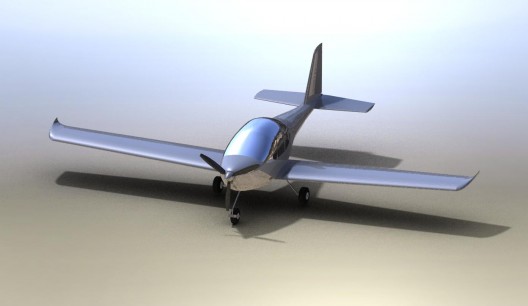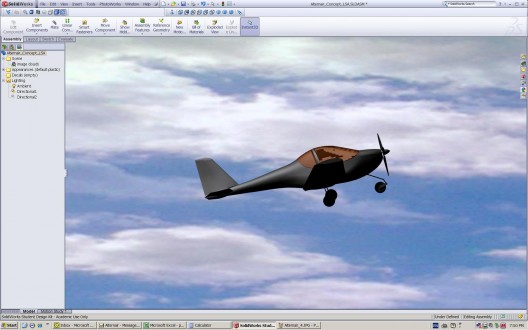Stephan Boutenko, Alternair President and founder, seeks a Light Sport Aircraft alternative, an airplane looking like an LSA, but loaded with features that will allow it to keep pace with the rapidly changing options coming to electric flight.
Inspired by Yuneec’s E-430 but disappointed by its slow cruising speed, Boutenko was determined to create something more in line with LSA performance criteria. He also wanted to take advantage of the knowledge he had gained from years of experience with heavier aviation to create an integrated system that would allow flexibility and expandability in the development of his airplane. Unabashedly conventional in appearance, the low-wing, tricycle geared monoplane is conceived to make a pilot transitioning from an internal combustion powered machine feel right at home. The motor control electronics (MCE), for instance, are redundant, and the key-operated switch on the instrument panel has an OFF/ L(EFT MCE)/R(IGHT MCE)/BOTH function, matching the ignition switch for dual magnetos.
Beyond that bow to tradition, the inner workings of the Alternair Amp are anything but traditional. Its batteries, for instance, are carbon nanotube (CNT) lithium polymer packs, able to power the 50 kW (68 horsepower) electric motor for two hours, enough for local flying, or an excursion to the traditional $100 hamburger. Boutenko has considered the effects of weather and other unplanned elements in flight, so the airplane has a range of 200 miles at 90 knots (103.5 mph) with a 30-minute VFR reserve, or enough for one “go-around” at the destination airport. This projected performance is based on the need to use all 50 kW for takeoff, 11 kW to cruise at 90 knots, and a total battery capacity of 34 kilowatt hours (kWh), distributed among a 10 kWh pack in each wing root and a configurable 14 kWh pack behind the passenger compartment. An aerolastic propeller flattens in pitch during full-power takeoff and takes on a coarser pitch at the 11 kW cruise power, giving the effect of a constant speed unit and helping allow the efficiency necessary for electric flight.
Further tracing the electrical heart of the craft, flight and non-flight related components connect to a Common Core System (CCS), based on ARINC 664 AFDX (Avionics Full Duplex Switched Ethernet) architecture, which hosts functions required to operate the airplane’s various modules, while monitoring electrical, mechanical and software systems and recording faults. It’s the same software package used on Airbus, Boeing, and now Bombardier airplanes. These records are stored in the Aircraft Health Management Function (AHMF) and can be uploaded to the maintenance laptop for review. The system alerts the pilot of any flight-critical faults through a10-inch display, one of two that can be mounted on the panel, along with a VHF radio, Mode S transponder, or GPS receiver. Optionally, the panel can hold an iPhone or Touch to display an electronic checklist. The display function (DF) can also display and accept entries on the aircraft and maintenance logbooks.
All this electronic wizardry will be transparent to the pilot, who will see a carbon-fiber aircraft with a gross weight of 1,320 pounds, payload of 440 pounds, and performance that emulates the LSA ideal. Able to lift off in 450 feet and land in 500, the Amp is designed for at least a 600 feet per minute climb (with refinements – 800 fpm), a 43 knot (49.5 mph) clean stall speed, and 39 knot (45 mph) stall with flaps, making the 37-foot wingspan craft easily managed by the average pilot. Batteries comprise 550 pounds of the total aircraft gross, the structure and motor 330 pounds.
Attention to detail and carefully thought out power management and flight profiles are essential to the development of successful electric aircraft, and it’s clear that Stephan Boutenko and his talented crew have thought things through with depth and precision. Like all startups, Alternair is looking for funding and sponsorship for its possible participation in the Green Flight Challenge and the Lindbergh Electric Aircraft Prize (L. E. A. P.) This practical, user-friendly airplane, with an operating cost that Boutenko estimates at 20-percent of its gas-powered competition, will undoubtedly win friends when it shows up at the local airport.



Comments 9
Well done Stephan! It looks like your concept is under way.
It’s only because of those with uncommon vision we have been able to acomplish
anything.
Chaz
This is a very welcome development. If battery technology keeps improving the way it is we will see Electric LSAs with true cross-country range very soon.
The airplane though is only one (central) element of the system. What about recharging batteries away from the home base? Is it as simple as plugging the aircraft into a power outlet at a local FBO? How long would a charging cycle take? Will self-serve AVGAS pumps come with a power outlet in the future?
Author
You ask an important question, one which CAFE has been working on in collaboration with NASA and other entities. The hope would be that airports would eventually have facilities available to support electric flight. Charging times will come down as batteries are developed that allow quick charges without loss of cycle life or reduction in total charge.
Consider too what Nellis AFB and the Medford, Oregon airport have done. They have solar farms on site, with panels on hangar roofs and in the spaces around runways and taxiways. Think of what a good neighbor an airport would become if it supplied electricity to the surrounding area, and if airplanes were whisper quiet as they passed over.
Some electric aircraft designers are incorporating solar panels on the roofs of their craft’s hangars as a means to keep the aircraft inside permanently charged. The Silent AE-1 sailplane has been charged using an on-field solar panel (not too large, either, for this almost ultralight electric soarer).
This is, indeed, is a very important question. Alternair presently has two visions – a one with a flying light sport airplane capable of a 2.5 hour endurance and a 200 nautical mile range, and another with more and more airports being equipped with available electric power to charge an airplane (or a car, or a delivery truck), whether for a fee or as a courtesy. I am currently in communications with several small and big players in the industry working on a variety of solutions ranging from solar charging stations to electric car-compatible 240/480VAC quick charge stations.
This is the most brilliant development cosidering that just a few years ago electric aircraft were barely getting off the ground. It is not clear from the article but is this a 2 seater? From the payload at 440 pounds it seems to be. I have been trumpeting this development loud and wide.
We are entering an entirely new age. With the recent announcement of the VW Milano EV taxi (120kph/300k range/45kwhr charge/1 hr to 80% charge/$A8 to fill/1500 Kg weight) the Alternair Amp consolidates Electric power as the new force in transport. Nothing can turn back the clock.
Apart from my own small plane design under way (3 seater amphibian non electric) my technology group is designing, what we have dubbed, GenII PV. This is a system using existing technology which, along with our (under development) ultra high efficiency inverters, promises to provide 10Kw PV power (19,000Kwhrs for Sydney insolation conditions), 8 to 15 kw airconditioning, hot water and space heating, all from one system, and intended for residential and small business installation. When all of these technologies mature over the next 3 to 5 years The world will start to change to fulfill the imaginings of the futurists of last century. Just think about that, an aircraft that will with ? people cover 300 to 350 kilometres in 2hours on $6 fuel cost, cleanly and quietly. This is all so exciting.
Apart from my own small plane design under way (3 seater amphibian non electric) my technology group is designing, what we have dubbed, GenII PV. This is a system using existing technology which, along with our (under development) ultra high efficiency inverters, promises to provide 10Kw PV power (19,000Kwhrs for Sydney insolation conditions), 8 to 15 kw airconditioning, hot water and space heating, all from one system, and intended for residential and small business installation. When all of these technologies mature over the next 3 to 5 years The world will start to change to fulfill the imaginings of the futurists of last century. Just think about that, an aircraft that will with ? people cover 300 to 350 kilometres in 2hours on $6 fuel cost, cleanly and quietly. This is all so exciting.
Very beautiful plane
Please send info on electric aircraft to:
Richard Caesar
4314 Marina City Dr #530C
Marina del Rey, CA 90292
Thank you!
Alternair was put on ice Sep 10, 2014 due to lack of funding, however Dec 14, 2014 mysteriously announced “The Amp-100 has been funded! Stay tuned for more updates to come!” per their Facebook site (https://www.facebook.com/Alternair). Dean, it might be worth checking in with them to see what’s up.